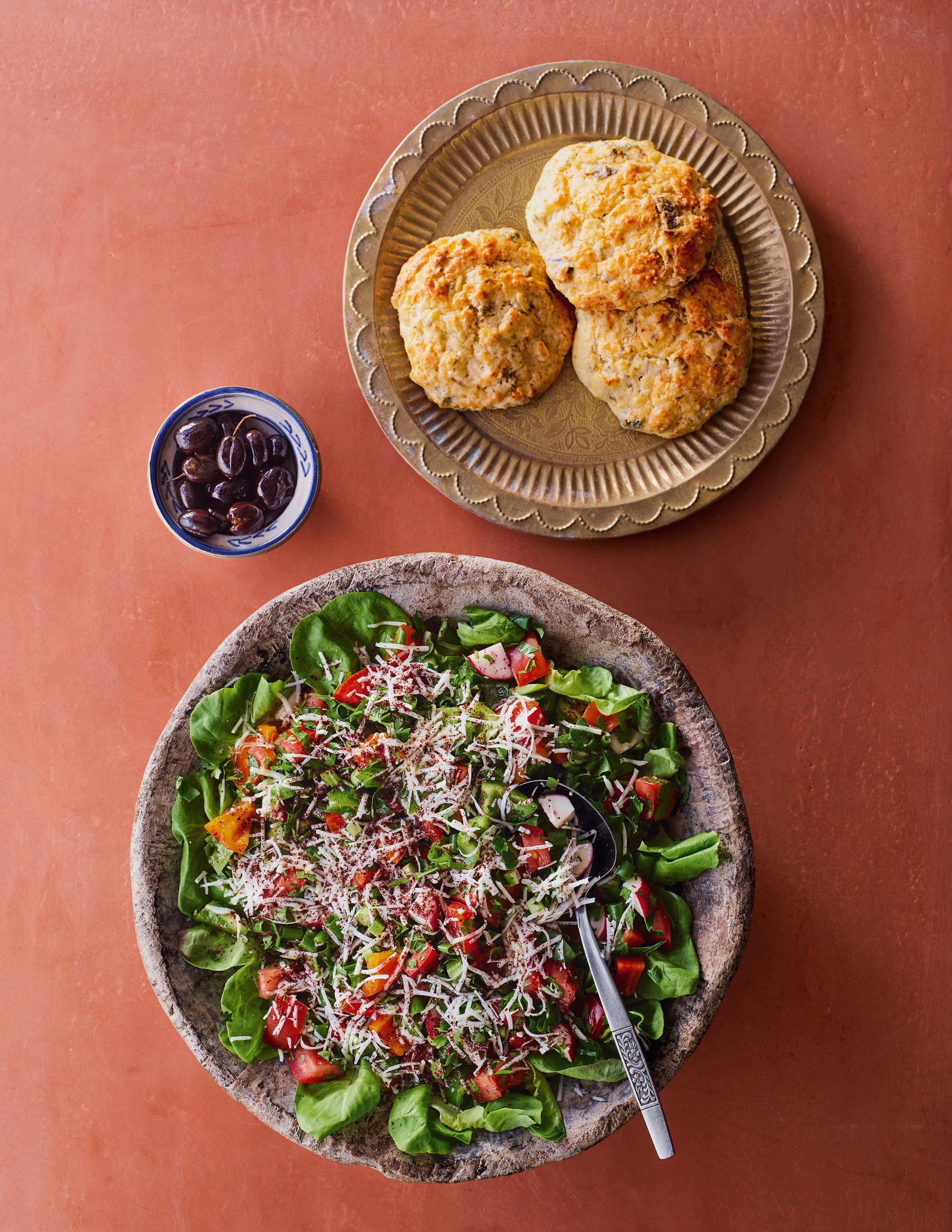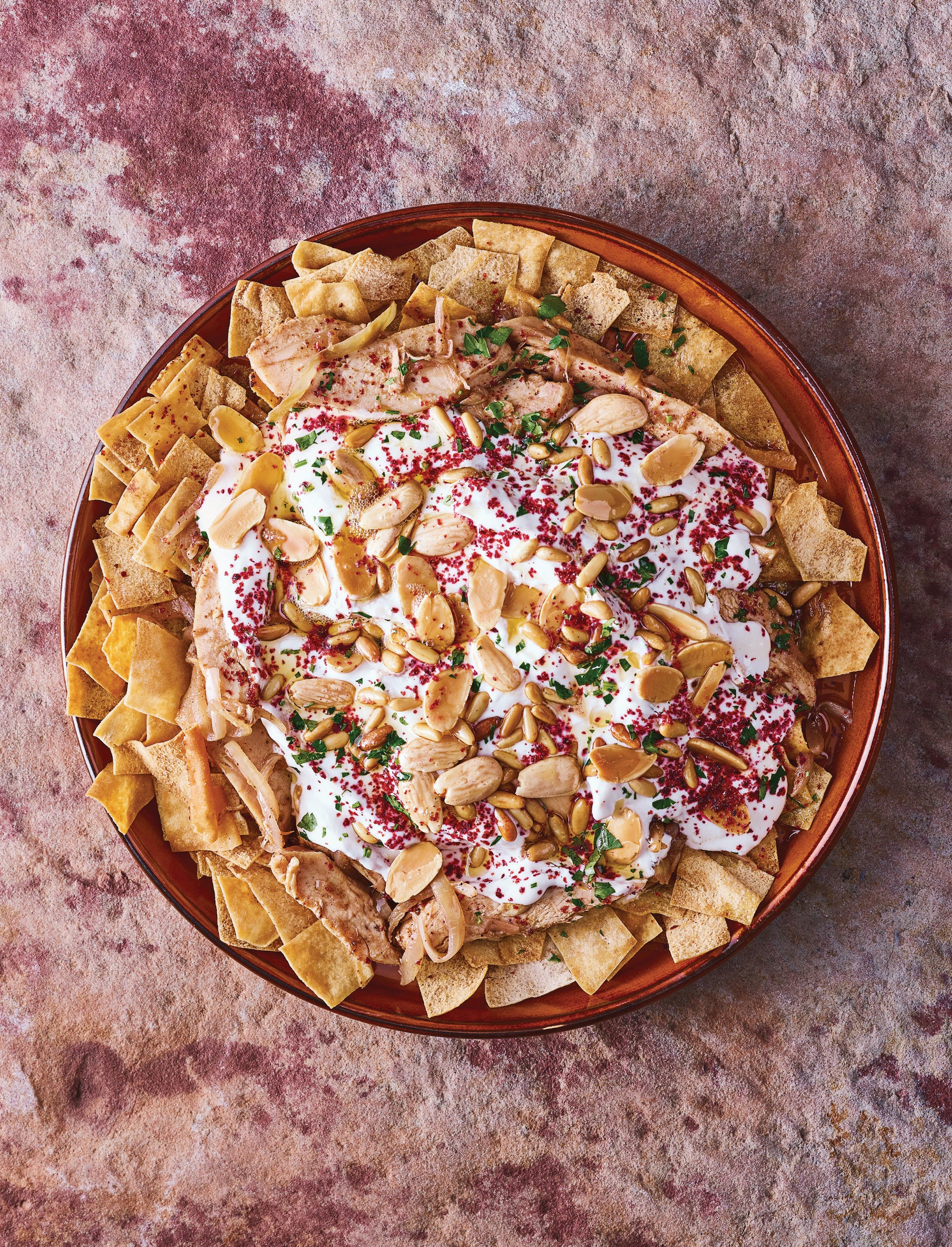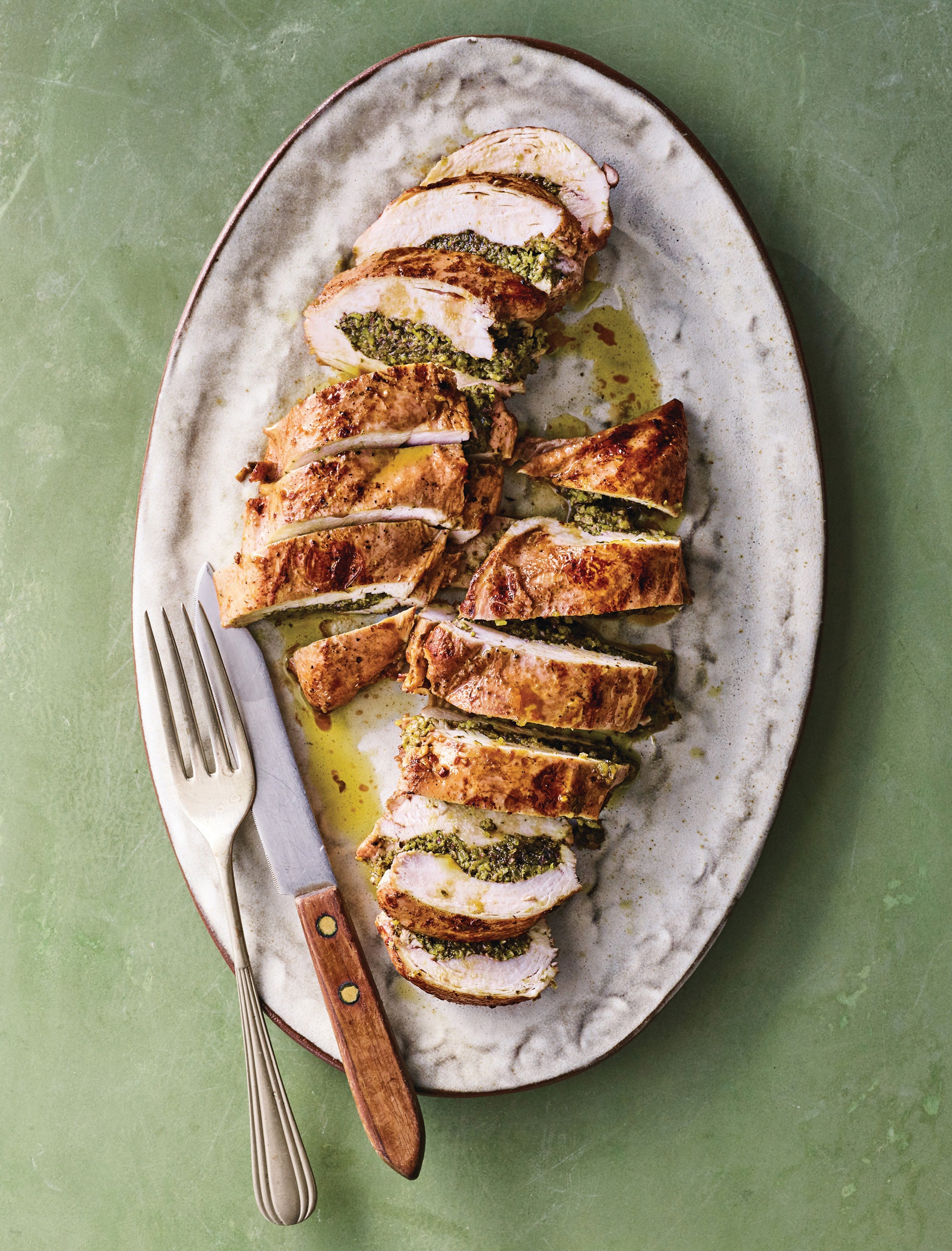But that’s all to do with perception and learning how to integrate those ingredients into your daily food preparation. The more you use
pomegranate molasses or preserved lemons, the less it feels like an investment and you’ll know that you’re getting your money’s worth.Learning the history of those ingredients will only add to the experience. Instead of having a bottle of something perhaps unfamiliar to your palate languishing at the back of the cupboard, you can find new ways to incorporate it into your cooking.
Reem Kassis‘ book The Arabesque Table is a perfect window on the flavours and ingredients which are integral to Arab food. The recipes don’t just encourage you to try the flavours but help you to really understand the many ways they can be used. Za’atar and sumac are two great examples of this.Ahead we’ve extracted six of Kassis’ beautiful recipes using za’atar and sumac, as well as her text exploring why they are so important to Arab cuisine. You’ll never let your ‘speciality’ ingredients go untouched for months again.
—–
The least understood yet most recognised ingredient of the Middle East has to be za’atar. Za’atar has been a staple in Arab cuisine since the Middle Ages, and evidence points to it having been used as far back as Ancient Egypt. Contrary to what some may think, za’atar is not thyme or a mixture of different dried herbs and spices. Za’atar is an actual plant native to the Levant, most closely related to oregano. In season, it is foraged and the leaves picked and used in various ways. When I was a child, every spring my family would take trips to the mountains surrounding Jerusalem to pick za’atar leaves. We used some in salads and bread, then dried the rest for use throughout the year. The most recognised item sold as za’atar in the West is the condiment, traditionally made by drying the herb’s leaves and then crushing and mixing them with sesame seeds and sumac to form a mixture enjoyed with bread and olive oil. But the leaves are also used fresh in salads or folded into pastries. Today, I also use za’atar as a way to add flavor to foods and give them an Arab flair.
Sumac, a component of the za’atar blend we have come to know and love in the West, has its own fascinating history. Prevalent in medieval Arabic cookbooks, there are entire sections dedicated to dishes made with either its juice or its powder. Summaqiyat is a whole category of stews made with sumac, but there are plenty of other dishes in which it is used to flavour chicken, lamb, and even pickles. Its uses today seem to have become less varied, although there are still a few places, like Gaza, where sumaqiya is one of the most recognised local dishes. Generally perceived as Middle Eastern, there are in fact many species of sumac that are native to North America where it was gathered and put to multiple uses by native Americans and continues to be foraged across the continent today.
Sumac is a flowering plant whose berries are used in cooking. They are dried, ground, and then sifted. The sifting is important because it gets rid of the inner seed, which is bitter, and leaves the skin, which is a beautiful crimson colour with a sour flavour. What is sold in stores is at times not sifted, mixed with salt, or even worse, a combination of citric acid and food colouring. So the best advice I can give is to choose a trusted brand with no additional ingredients, or if you have access to the plant, pick and dry your own, then grind and sift.
Both za’atar and sumac are what I like to call “flavour makers” because they brighten up dishes and give them depth. Many of my recipes feature these ingredients—but take them as a blueprint. Za’atar can be used to flavour pastries and breads, but don’t settle for the options I have given here. Experiment with your favourite loaf, or your preferred pastry for a new twist. Sumac can be used in place of lemon juice or pomegranate molasses or anytime you want something sour. Use it in salad dressings or to marinate chicken before grilling. The recipes here will, I hope, get you familiar with the flavour notes of these two magical ingredients. From there, what you can do with them is boundless.

Serves 2-4
Ingredients
3 tbsp olive oil, plus more for drizzling
550–600 g russet (baking) or red potatoes (about 3 medium), cut into 2 cm cubes
1 small red or green bell pepper, cut into 2 cm pieces
2 fresh red or green chili peppers, such as jalapeño or Anaheim, thinly sliced (omit if you don’t like spice)
1 small onion, diced
1 tsp salt
¼ tsp ground cumin
A few twists of black pepper
4 eggs
2 tsp za’atar blend
Fresh za’atar or oregano leaves, for garnish
Instructions
1. In a large lidded nonstick or cast-iron skillet, heat the olive oil over medium-high heat. Add the potatoes and cook, tossing frequently, until just starting to brown around the edges, 10–15 minutes.
2. Add the bell pepper, chilies, and onion and continue to cook, tossing periodically, until the potatoes are golden brown and crisp all over, another 15 minutes.
3. Add the salt, cumin, and black pepper and give everything one more toss. Make 4 wells in the potato mixture with the back of a large spoon and crack an egg into each well.
4. Drizzle some olive oil on top of the eggs and sprinkle with the za’atar. Cover the pan and cook until the whites are set. If you prefer a runnier yolk, you can spoon the whites gently away from the yolk so you have thinner whites that will cook faster. Remove from the heat, garnish with fresh za’atar leaves, and serve immediately. Photographed by Dan Perez.

Serves 4–6
Ingredients
85 g labaneh, preferably homemade
Scant 1 tbsp za’atar blend (optional)
750 g heirloom or good-quality slicing tomatoes or cherry tomatoes (a mixture of colours looks pretty here)
2 tbsp extra-virgin olive oil
1 clove garlic, very finely chopped
1 tbsp fresh lemon juice
1 tsp sumac
Maldon sea salt
2–3 sprigs fresh za’atar, leaves picked (or use fresh oregano or marjoram, or in a pinch, thyme)
Bread, for serving
Instructions
1. Line a sieve with paper towels and set over a bowl. Spoon the labaneh into the sieve and allow to sit for about 1 hour at room temperature, until some of the liquid has drained and it is drier and easier to roll. Transfer to a bowl, add the za’atar blend (if using), and mix to combine.
2. Line a flat plate with parchment paper. With lightly oiled hands, roll the labaneh into balls the size of marbles and set on the plate. Cover with clingfilm and refrigerate until ready to use.
3. Slice the tomatoes into rounds 1 cm thick and arrange on a serving platter.
4. In a small bowl, whisk together the olive oil, garlic, and lemon juice. Spoon the mixture over the sliced tomatoes. Sprinkle with the sumac and salt flakes. Top with the labaneh balls and scatter with the fresh za’atar leaves. Serve with bread. Photographed by Dan Perez.

Makes 12 scones
Ingredients
270 g all-purpose (plain) flour
1 ½ tsp baking powder
1 tsp salt
125 g cold unsalted butter, cut into cubes
85 g feta cheese
85 g halloumi cheese, grated
Small handful of fresh za’atar, thyme, or oregano leaves, or a combination, finely chopped (or in a pinch, 2 tbsp za’atar blend)
3 eggs
120 ml whole milk
Instructions
1. Preheat the oven to 350°F (180°C/Gas Mark 4). Line a baking sheet with parchment paper.
2. In a large bowl, combine the flour, baking powder, and salt. Tip in the cold cubes of butter and cut into the flour using a fork, pastry blender, or your fingertips until the mixture resembles oats but you can still see some pea-size flecks of butter.
3. Finely crumble the feta cheese. If the feta is too watery, set on paper towels for a few minutes after crumbling. Add the feta, grated halloumi, and za’atar to the flour and mix to combine.
4. In a separate bowl, whisk together the eggs and milk until fully combined and the mixture is a pale yellow and lightly frothy. (I often use a hand blender to do this quickly.) Pour the egg mixture over the flour and mix with a spatula until blended.
5. Using an ice cream scoop, drop heaping spoonfuls onto the lined baking sheet. You will end up with around 12 scones. Bake until golden brown around the edges but still soft in the center, 20–25 minutes. Serve immediately or transfer to a wire rack to cool before storing.
6. Scones are best eaten the day they are made.Photographed by Dan Perez.

Serves 4
Ingredients
For the squid:
500 g cleaned squid, tubes cut into rings (see Note)
2 tbsp olive oil
1 tbsp fresh lemon juice
1 tsp salt
½ tsp garlic granules
½ tsp mild curry powder (fenugreek, cumin, and coriander included)
½ tsp paprika (or hot chili)
For the sumac onions:
1 small red onion, sliced into thin half-moons
2 tbsp finely chopped fresh parsley leaves
1 tsp sumac
1 tsp extra-virgin olive oil
Pinch of salt
For the chopped salad:
3 tomatoes, finely chopped
2 mini cucumbers, finely chopped
1 small bell pepper, finely chopped
3 small cucumber pickles, finely chopped
1 tbsp finely chopped fresh parsley leaves
1 tbsp fresh lemon juice
1 tbsp extra-virgin olive oil
½ tsp salt
For the amba chili tahini:
Amba Tahini
½ tsp Shattah Chili Paste or more to taste
Salt
For assembly:
2 tbsp olive oil
Pita bread or flatbread
Instructions
1. Prepare the squid:
In a medium bowl, combine the squid, olive oil, lemon juice, salt, garlic granules, and spices and gently mix until fully coated. Allow to sit in the refrigerator while you prepare the remaining elements.
2. Make the sumac onions:
In a bowl, stir together the onion, parsley, sumac, olive oil, and salt. Cover and set aside.
3. Prepare the chopped salad:
In a large bowl, toss together the tomatoes, cucumbers, bell pepper, pickles, parsley, lemon juice, and olive oil. Add the salt right before serving.
4. Make the amba chili tahini:
In a bowl, stir together the amba tahini and chili paste until evenly incorporated. If you prefer a runnier drizzling consistency, add water a tablespoon at a time and mix well until you reach the desired consistency. Taste and adjust salt and lemon to your liking.
5. To assemble:
In a large frying pan, heat the olive oil over high heat until shimmering. Add the squid and cook, tossing frequently, until opaque and cooked through, 2–3 minutes. Do not overcook to avoid making tough.
6. Remove from the heat and transfer to a plate. Serve with bread, the sumac onions, chopped salad, and amba chili tahini so each person can make their own sandwich.
Note: You can swap out the squid for a firm-fleshed white fish, such as tilapia, monkfish, mahi mahi, or halibut, sliced into thin strips. If you do, I recommend baking the fish rather than pan-frying to avoid breaking up the fish, which is more delicate. Simply preheat the oven to broil (grill), line a baking sheet with parchment paper, spread the fish in a single layer without crowding, and broil until opaque throughout and browned around the edges, about 10 minutes. Keep an eye on the fish because timing may vary considerably depending on the size of the strips, the kind of fish, the size of oven and the distance from the heat.Photographed by Dan Perez.

Serves 4–6
Ingredients
3 large, thin Lebanese pita breads (about 85 g each), cut into 2 cm squares, or flour tortilla wraps in a pinch
For the yogurt sauce:
500 g yogurt (regular, Greek, or a combination)
4 tbsp fresh lemon juice
2 tbsp tahini
1 large clove garlic, crushed in a garlic press
½ tsp fine salt
For the chicken and onions:
700–900 g boneless, skinless chicken breasts (about 3)
1 tbsp coarse sea salt
1 bay leaf
3–5 allspice berries
120 ml olive oil
1 kg onions (about 3 very large), sliced into thin half-moons
1 tbsp plus 1 tsp fine salt
3 tbsp sumac
1 tsp ground cumin
½ tsp Nine-Spice Mix, baharat, or Lebanese 7-spice blend
6 tbsp pine nuts, toasted or fried
For assembly:
2 tbsp pine nuts, toasted
Very small handful of fresh parsley, finely chopped
Sumac
Extra-virgin olive oil, for drizzling
Instructions
1. Preheat the oven to 350°F (180°C/Gas Mark 4).
2. Arrange the pita bread squares on a baking sheet. Bake until the squares are dry and crisp and starting to darken in colour, moving them around with a wooden spoon from time to time, about 15 minutes. (This step can be done several days in advance and the pita chips stored in an airtight container or a zipseal plastic food bag.)
3. Make the yogurt sauce:
In a bowl, whisk together the yogurt, lemon juice, tahini, garlic, and salt until fully combined. Refrigerate until ready to assemble.
4. Prepare the chicken and onions:
In a large saucepan, combine the chicken, coarse salt, bay leaf, allspice berries, and water to cover. Bring to a bare simmer over medium heat, then reduce the heat to low and cook until the chicken is fully cooked and registers 165°F (74°C) on an instant-read thermometer, 15–20 minutes. Remove from the heat, discarding the broth, and wash any scum off the chicken breasts. Set the chicken aside, covered, until cool enough to handle. Once cooled, pull the chicken into very thin shreds.
5. Meanwhile, in a large frying pan, heat the olive oil, onions, and 1 tablespoon of the fine salt over medium-low heat. Cook, stirring periodically, until the onions have softened and cooked completely, 30–40 minutes. Toward the end, add in 2 tablespoons of the sumac, the cumin, and spice blend and stir to incorporate.
6. When the onions are fully cooked, add the shredded chicken, the remaining 1 tablespoon sumac, and 1 teaspoon fine salt and cook, stirring regularly, for another 3–5 minutes to meld the flavours. Add the pine nuts and toss to mix through.
7. To assemble:
Place the toasted bread at the bottom of a large serving platter with raised edges. Top the bread with the chicken and onion mixture. Pour the yogurt sauce evenly on top, smoothing out with a spoon if necessary. Sprinkle with the toasted pine nuts, parsley, sumac, and a drizzle of olive oil. Serve immediately to retain the crunchiness of the bread Photographed by Dan Perez.

Serves 4 (can easily be halved)
Ingredients
For the chicken:
4 boneless, skinless chicken breasts
2 tbsp olive oil, plus more for frying
2 tbsp pomegranate molasses
2 tsp salt
½ tsp freshly ground black pepper
For the pistachio stuffing:
100 g pistachios
20 g packed mixed green leaves: a combination of any combination of radish tops, mint, cilantro (coriander), watercress, or parsley
2 cloves garlic, peeled
1 tbsp olive oil, plus more for frying
2 tsp fresh lime or lemon juice
1 tsp sumac
1 tsp grated Parmesan cheese
Scant 1 tsp salt
¼ tsp freshly ground black pepper
Instructions
Prepare the chicken:
1. With the tip of a sharp knife, make an incision horizontally in the fatter side of each breast to make a large pocket but without cutting through and keeping the breast intact. Place the chicken breasts in a bowl. Add the olive oil, pomegranate molasses, salt, and pepper and rub the chicken all over—inside and out—with the mixture. Cover and refrigerate for a couple of hours and up to overnight.
2. Make the pistachio stuffing:
In a mini food processor, combine the pistachios, mixed greens, garlic, olive oil, lime juice, sumac, Parmesan, salt, and pepper and process into a coarse paste. Preheat the oven to 350°F (180°C/Gas Mark 4).
3. Dividing evenly, spoon stuffing into the breast pockets, using your hands or the back of a spoon to smooth it into an even layer. You can use toothpicks (cocktail sticks) to hold the edges of the breasts together if necessary.
4. In a large cast-iron skillet or ovenproof frying pan, heat a couple tablespoons of olive oil over medium heat. When the oil is hot but not smoking, add the breasts in a single layer and cook for 3–4 minutes per side, flipping only once when the chicken easily releases from the pan.
5. Transfer the pan to the oven and bake until a meat thermometer inserted into the thickest part of the breast registers 165°F (74°C), 10–15 minutes.
6. Remove from the oven and allow to rest for 5 minutes before serving. Photographed by Dan Perez.
Like what you see? How about some more R29 goodness, right here?